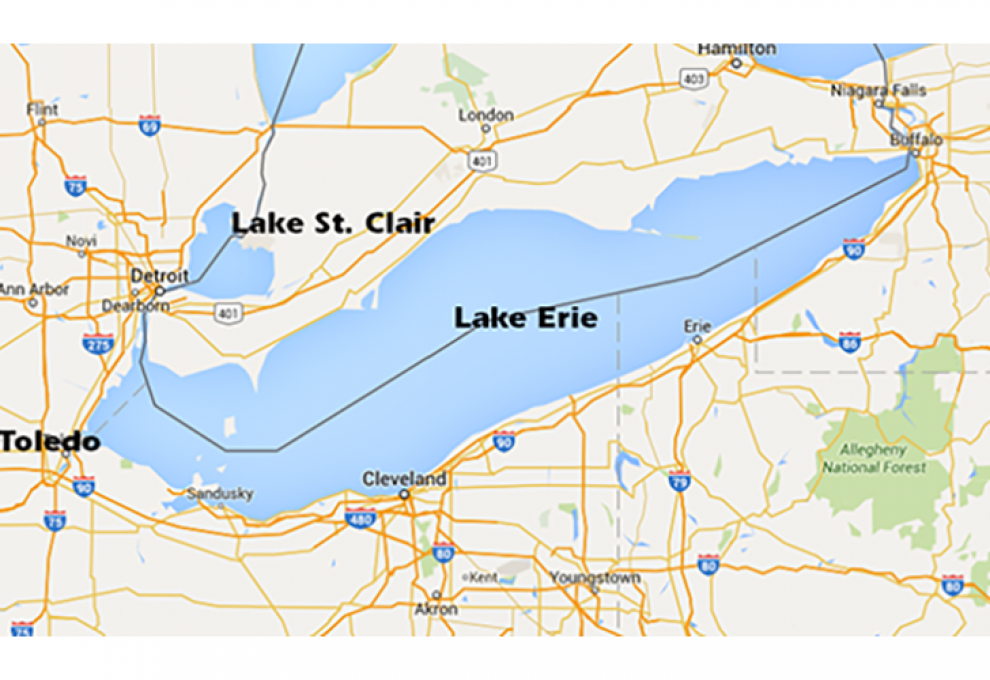
Lake Erie is ground zero for new environmental monitoring in Ontario. Concern over the health of the lake was renewed in 2014 when toxic algal blooms caused the city of Toledo, Ohio to stop intakes for drinking water.
This cross-border issue is putting pressure on Ontario farmers, specifically in the Thames River watershed which runs into Lake St. Clair and tributaries in the Leamington area. Stateside, the Maumee River and Sandusky river systems that flow through the heart of Ohio agricultural regions have been identified as major U.S. contributors to phosphorus in the western basin.
As Bruce Kelly, environmental project manager for Farm and Food Care Ontario, reports on page 12 of this issue, agriculture, along with other sectors, is being coaxed to reduce the amount of phosphorus going into Lake Erie by 40 per cent by 2030. It’s an aspirational target. He’s careful to point out that does not mean reducing phosphorus fertilizer use by 40 per cent but rather working strategically to reduce the small amount that might currently be leaving farmland through soil erosion or dissolved in spring melt water.
However, research is still lacking on how to advise farmers on the practicalities and suitability of some of the best management practices for controlling phosphorus losses across a range of environmental conditions. Professor Ivan O’Halloran at the University of Guelph, Ridgetown Campus, who specializes in soil fertility and nutrient use efficiency, explains why.
“While we may be reducing overall phosphorus loading into Lake Erie, we may not be reducing the soluble phosphorus,” he says. “It’s the soluble phosphorus that’s biting us now in terms of algal blooms. We’ve reduced the particulate phosphorus but not the soluble phosphorus which is more bioavailable. Very small amounts can have a significant unwanted environmental impact.”
For example, O’Halloran explains that the inter-relationships between soil type, soil test P levels and cover crops species are not completely understood. Cover crops vary in their effectiveness for controlling soil erosion and the loss of soil bound (or particulate) phosphorus from farmland. Cover crops can also be a source of soluble phosphorus loss, particularly during spring snow melts. These losses also can vary with the age and species of cover crop.
Higher soil test P levels also give greater risks of both soluble and particulate phosphorus loss in runoff, and typically higher soluble phosphorus levels in plants. So at what point in a given field does the risk of soluble phosphorus loss with a cover crop exceed the benefit of reduced erosion and reduced total phosphorus loss? Often the importance of these inter-relationships is lost when the main message is generalized to a simple statement that says cover crops are either good or bad for controlling phosphorus loss.
What researchers seem to agree on is that the practice of fall broadcasting of dry fertilizer without incorporation seems a likely contributor to the problem. O’Halloran says that fall broadcasting might be convenient and allows for more time for other operations in the spring, but it’s not the best management practice agronomically or environmentally. He understands that farmers might also be taking advantage of better fertilizer prices in the fall and that suppliers are moving fertilizer to farms for logistical reasons, but he reasons that farmers in high-risk areas should warehouse fertilizer until the spring.
Fortunately, Mark Wales, a section chair for the Ontario Fruit and Vegetable Growers’ Association, sits as the only Canadian farmer on the Great Lakes Water Quality Board. This 28-member, volunteer board advises the International Joint Commission (IJC) on the Great Lakes which in turn advises the respective national governments.
Ontario has accepted the IJC recommendations for reduced phosphorus loading in Lake Erie, Wales reports, but it’s not a hard target. It’s hoped that 20 per cent of the target will be reached by 2020. The positive news is that most of the phosphorus problem is generated on the American side of the border.
“The U.S. accepts that 90 per cent of the loading is on its side of Lake Erie, and that agriculture, sewage plants and stormwater management need to be better,” says Wales. “Ohio has just banned the practice of spreading manure on snow or frozen soil. We’ve had this rule in place in Ontario since 2003 as a result of the Nutrient Management Act. And Ontario farmers do very little fall fertilizing. Overall, Ontario agriculture is ahead of the curve on this issue.”
Wales believes that best management practices will evolve as more research and monitoring reveal more hard data. Two facts are worth noting now. First, 40 per cent of the lake sediment is contaminated with phosphorus and significant phosphorus can be found in stream banks and sediments. Farmers can’t influence what’s already embedded. Secondly, researchers who examined runoff data are showing how most of the phosphorus loading occurs between November and April, when more extreme weather events tend to occur.
With that knowledge, farmers can begin to implement target practices to prevent runoff during this critical period. The challenge is to examine nutrient use schedules and try to figure out how to keep nutrients away from spring melt waters.

Add new comment